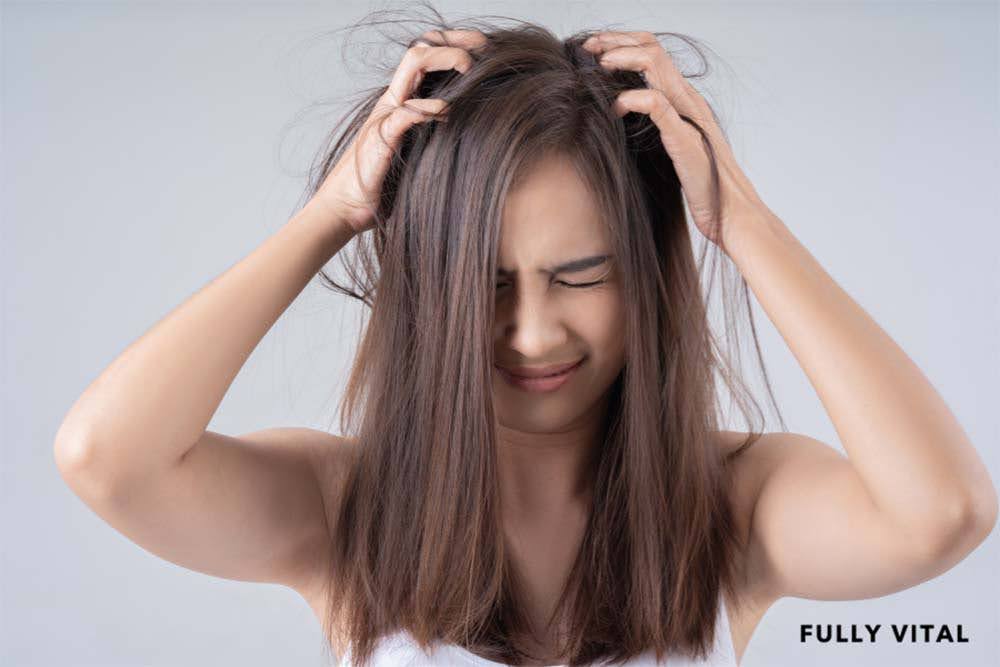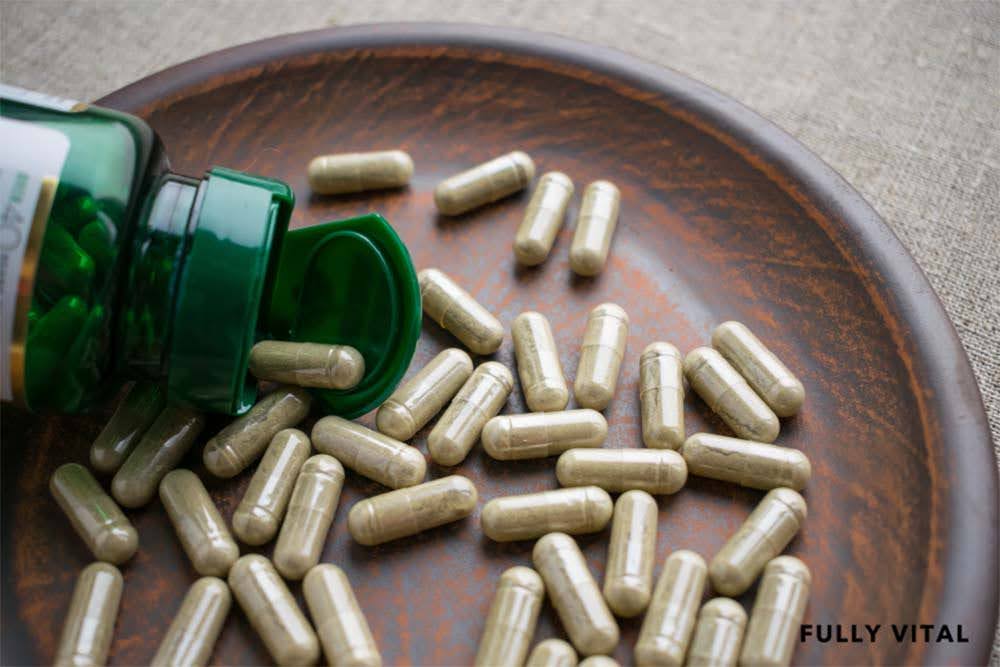
Say Goodbye To Hair Damage: Proven Methods For Effective Repair
Hair damage can be a real struggle for women of all hair types.
Whether it's due to heat styling, chemical treatments, or environmental factors, damaged hair can make it difficult to achieve the desired look and feel.
But don't worry, there are proven methods for effective hair damage repair and stimulating hair growth.
In this article, we will cover everything you need to know about repairing hair damage and promoting hair growth.
So say goodbye to hair damage and hello to luscious locks!

I LOVE MY HAIR NOW
FullyVital hair serum and hair vitamins made tremendous improvements in my hair. I truly love my hair now.
Dorit S.,
What Is Hair Damage Repair?
Hair damage repair refers to the process of restoring and rejuvenating damaged hair.
It involves repairing the hair strands from within, improving its texture, strength, and overall health.
Hair damage can manifest in various forms, such as split ends, breakage, frizz, and lack of shine.
Effective hair damage repair techniques help reverse these issues, leaving you with healthier and more manageable hair.1
Why Is Hair Damage Repair Important?
Hair damage repair is crucial for several reasons.
Firstly, it helps maintain the overall health and integrity of your hair.
By repairing damaged hair, you can prevent further breakage and promote healthy growth.
Secondly, repairing hair damage can enhance the appearance of your hair, making it look smoother, shinier, and more vibrant.
Lastly, damaged hair can be challenging to style and manage, so repairing it allows for easier hairstyling and maintenance.2
Common Causes Of Hair Damage
Hair damage can occur due to various reasons.
Here are some common causes of hair damage:
Heat Styling
- Excessive use of heat styling tools like flat irons, curling irons, and blow dryers can lead to hair damage.
- High temperatures strip away the hair's natural moisture, making it dry and prone to breakage.
Chemical Treatments
- Chemical treatments such as hair coloring, perming, and relaxing can cause significant damage to the hair.
- These treatments often involve harsh chemicals that weaken the hair structure and lead to breakage and dryness.
Overexposure to the Sun
- Excessive exposure to the sun's harmful UV rays can damage the hair cuticle, resulting in dryness, brittleness, and color fading.
- UV damage is more pronounced in light hair colors and can also affect the scalp.
Environmental Pollution
- Pollution particles present in the air can settle on the hair, making it dull, brittle, and susceptible to damage.
- These pollutants can also clog the scalp pores, hinder hair growth, and cause scalp irritation.
Improper Hair Care Practices
- Rough towel-drying, aggressive brushing, and using harsh hair elastics can cause mechanical damage and breakage.
- Sleeping on rough fabric or tight hairstyles like ponytails can also contribute to hair damage.

Environmental Factors That Contribute To Hair Damage
Environmental factors can have a profound impact on the health of your hair.
Here are some factors to be mindful of:
Humidity
- High humidity levels can cause the hair to absorb excess moisture from the air, resulting in frizz and unruly hair.
- Conversely, low humidity can lead to dryness and brittle hair.
Extreme Temperatures
- Exposure to extreme cold or hot temperatures can stress the hair shaft and lead to damage.
- Cold weather can cause moisture loss and make the hair more susceptible to breakage, while excessive heat can dehydrate the hair.
Hard Water
- Hard water, which contains minerals like calcium and magnesium, can leave deposits on the hair and scalp.
- These deposits make it challenging for hair products to penetrate and may cause dryness and dullness.
Chlorine
- Swimming in chlorinated water can strip away the hair's natural oils, leaving it dry, brittle, and prone to damage.
- Wearing a swimming cap or rinsing the hair with fresh water before swimming can help minimize chlorine damage.
Air Pollution
- Pollutants in the air, such as particulate matter and chemicals, can settle on the hair and scalp.
- These pollutants can cause scalp irritation, clog hair follicles, and contribute to hair damage.
Chemical Treatments And Hair Damage
Chemical treatments can transform your hairstyle but also come with the risk of hair damage.3
Here's what you should know:
- Hair coloring: Permanent hair dyes often contain ammonia and peroxide, which can weaken the hair structure and cause dryness.
- Perming: Chemical perms break and reform the hair bonds, which can make the hair more susceptible to damage and breakage.
- Relaxing: Chemical relaxers contain strong alkalis that change the hair's structure, making it more vulnerable to damage.
The Role Of Genetics In Hair Damage
While external factors play a significant role in hair damage, genetics also influence the hair's overall health and susceptibility to damage. Some key points to consider:
- Genetic factors determine the inherent strength and resilience of your hair.
- Certain genetic traits can make hair more prone to damage and breakage.
- Hair thinning, early graying, and specific hair textures can be inherited traits.
- Genetics also influence how well your hair absorbs and retains moisture.
The Importance Of A Proper Hair Care Routine
Establishing and maintaining a proper hair care routine is vital for preventing and repairing hair damage.
Here's what you should include in your routine:
Regular Shampooing and Conditioning
- Choose a shampoo and conditioner suitable for your hair type and concerns.
- Shampoo your hair to remove dirt, oil, and product buildup, and follow up with a conditioner to nourish and moisturize the hair.
Deep Conditioning Treatments
- Incorporate deep conditioning treatments into your routine to provide intensive care to damaged hair.
- Look for products with ingredients like keratin, argan oil, or shea butter to restore moisture and improve hair strength.
Minimizing Heat Styling
- Limit the use of heat styling tools and opt for heat protectant sprays when necessary.
- Allow your hair to air dry whenever possible or use the cool setting on your blow dryer to minimize heat damage.
Protective Hairstyles
- Consider wearing protective hairstyles that minimize manipulation and reduce the risk of mechanical damage.
- Examples include braids, buns, and ponytails that keep the hair secure and prevent breakage.
Regular Trimming
- Trim the ends of your hair regularly to remove split ends and prevent them from traveling up the hair shaft.
- Regular trims promote healthy hair growth and maintain the overall appearance of your hair.

What Are The Benefits Of Hair Damage Repair?
Repairing hair damage offers numerous advantages, creating a holistic transformation for your hair:
- Strengthened Hair: By addressing damage, you can minimize breakage and split ends, ultimately fostering longer and healthier hair growth.
- Improved Manageability: Repaired hair is known for its enhanced manageability, making it significantly easier to style and maintain.
- Restored Radiance: Damaged hair often lacks its natural shine and luster, but proper repair can help restore its radiant appearance.
- Safeguard Against Future Damage: Beyond immediate benefits, repaired hair becomes less vulnerable to further harm, effectively protecting it from future external and internal stressors.
Unlock The Secret To Healthier, Younger-Looking HairExperience the transformative power of Fully Vital's science-backed hair growth products. Say goodbye to hair aging and hello to a revitalized mane! Discover the key features and benefits:
Embrace the future of hair care. Say hello to vibrant, luscious hair today! |
Final Thoughts On Hair Damage Repair
Hair damage repair is an essential aspect of maintaining healthy and beautiful hair.
Whether caused by heat styling, chemical treatments, or environmental factors, damaged hair can be repaired and rejuvenated with the right techniques and products.
By nourishing and strengthening the hair from root to tip, you can minimize breakage, enhance manageability, and restore your hair's natural shine and vitality.
With a rich history of natural remedies, evolving hair care products, and scientific breakthroughs, the importance of hair damage repair is undeniable.
At Fully Vital, we understand the significance of this topic and are dedicated to providing effective solutions for your hair care needs.
Explore our range of hair growth products that can help repair and revitalize your damaged hair, stopping the aging process and promoting a healthier relationship with your locks.
Say goodbye to hair damage and hello to a more vibrant and confident you.
Take the first step towards healthier hair today!
Frequently Asked Questions About Hair Damage Repair
What is the best product for badly damaged hair?
- For badly damaged hair, seek products that provide deep hydration and repair.
- Look for products with ingredients like shea butter, argan oil, and aloe vera, which can help nourish and restore damaged strands.
How long does it take to repair damaged hair?
- The time required to repair damaged hair varies based on the severity of the damage and your hair's natural growth rate.
- Visible improvements can be noticed within a few weeks to several months of consistent repair and care.
How can I regrow severely damaged hair?
- Regrowing severely damaged hair may require a combination of proper hair care and lifestyle changes.
- Focus on providing nourishment to your hair through a balanced diet, gentle hair care practices, and using products targeted for promoting hair growth.
What is the best product for extremely damaged hair?
- When dealing with extremely damaged hair, look for products specifically formulated for intensive repair and nourishment.
- Products containing ingredients such as keratin, protein, and natural oils are beneficial for restoring health to extremely damaged hair.
What damages your hair the most?
- While there are several factors that can contribute to hair damage, some common culprits include excessive heat styling, harsh chemical treatments, and lack of proper hair care practices.
- Environmental factors such as UV radiation, pollution, and exposure to chlorinated water can also damage the hair.
How do you know if your hair is permanently damaged?
- Permanently damaged hair may appear excessively dry, brittle, and prone to breakage.
- It may be resistant to normal repair methods and exhibit signs of severe damage such as split ends that continuously reoccur despite trimming.
What does chemically damaged hair look like?
- Chemically damaged hair can appear dry, brittle, and lackluster.
- It may have an uneven texture, and frequent use of chemical treatments may cause the hair to break easily.
What does damaged hair look like?
- Damaged hair often appears dull, frizzy, and lacks natural shine.
- Split ends, breakage, and an overall lack of smoothness are common signs of damaged hair.
How long does it take for damaged hair to become healthy again?
- The timeline for damaged hair to become healthy again varies depending on the extent of the damage and the effectiveness of the repair methods used.
- With consistent care and targeted repair techniques, significant improvements can be noticed within a few weeks to several months.
Is it necessary to cut off all the damaged hair for repair?
- In some cases, cutting off the damaged hair might be necessary, especially if the damage is severe and the hair is beyond repair.
- Trimming the damaged ends can promote healthier hair growth and prevent further splitting and breakage.
Sources:
- Kaushik, V., Chogale, R., & Mhaskar, S. (2020). Alternative protocol for hair damage assessment and comparison of hair care treatments. International Journal of Trichology, 12(1), 7. https://doi.org/10.4103/ijt.ijt_3_20
- How to Repair Damaged Hair: Common Causes and Treatments. (2018, February 21). Healthline. https://www.healthline.com/health/beauty-skin-care/how-to-repair-damaged-hair
- Gavazzoni Dias, M. F. (2015). Hair cosmetics: An overview. International Journal of Trichology, 7(1), 2. https://doi.org/10.4103/0974-7753.153450






